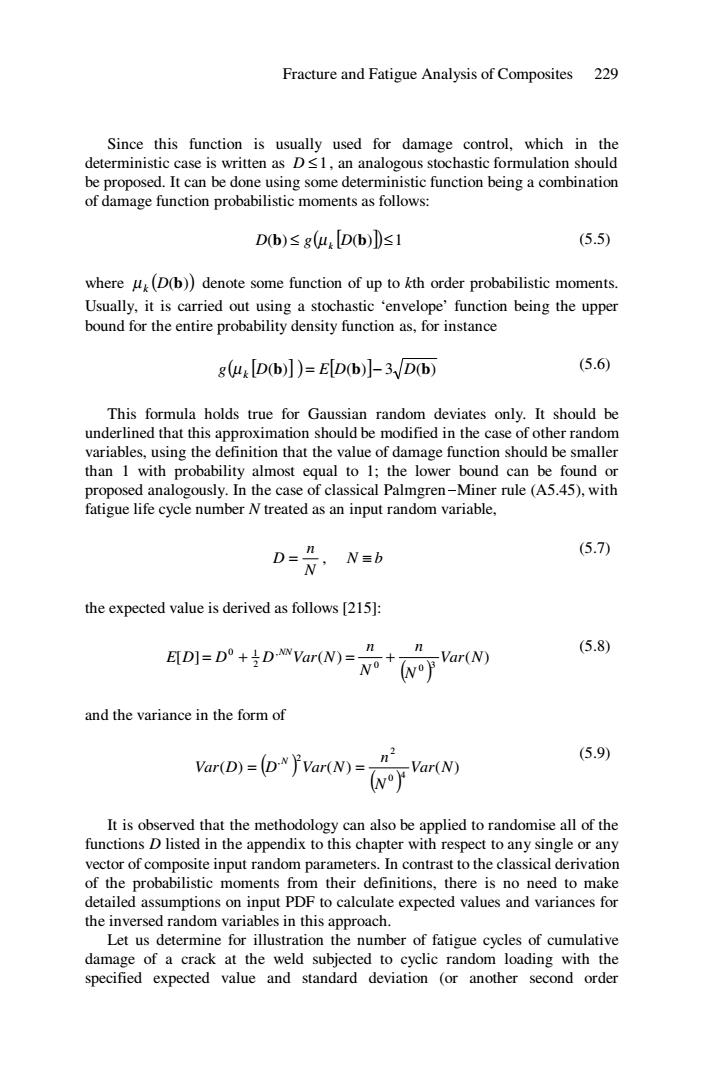正在加载图片...

Fracture and Fatigue Analysis of Composites 229 Since this function is usually used for damage control,which in the deterministic case is written as Ds1,an analogous stochastic formulation should be proposed.It can be done using some deterministic function being a combination of damage function probabilistic moments as follows: Db)≤guDb)Ds1 (5.5) where u(D(b))denote some function of up to kth order probabilistic moments. Usually,it is carried out using a stochastic 'envelope'function being the upper bound for the entire probability density function as,for instance 3(ux [D(b)])=E[D(b)]-3D(b) (5.6 This formula holds true for Gaussian random deviates only.It should be underlined that this approximation should be modified in the case of other random variables,using the definition that the value of damage function should be smaller than 1 with probability almost equal to 1;the lower bound can be found or proposed analogously.In the case of classical Palmgren-Miner rule (A5.45),with fatigue life cycle number N treated as an input random variable, D=” (5.7) N≡b the expected value is derived as follows [215]: ED]=D°+D-NVar(W)=” +a入) (5.8) and the variance in the form of ((N) (5.9) Var(D)=(DNVar(N)= It is observed that the methodology can also be applied to randomise all of the functions D listed in the appendix to this chapter with respect to any single or any vector of composite input random parameters.In contrast to the classical derivation of the probabilistic moments from their definitions,there is no need to make detailed assumptions on input PDF to calculate expected values and variances for the inversed random variables in this approach. Let us determine for illustration the number of fatigue cycles of cumulative damage of a crack at the weld subjected to cyclic random loading with the specified expected value and standard deviation (or another second orderFracture and Fatigue Analysis of Composites 229 Since this function is usually used for damage control, which in the deterministic case is written as 1 D ≤ , an analogous stochastic formulation should be proposed. It can be done using some deterministic function being a combination of damage function probabilistic moments as follows: D(b) ≤ g( ) [ ] D(b) ≤1 µ k (5.5) where ( ) D(b) µk denote some function of up to kth order probabilistic moments. Usually, it is carried out using a stochastic ‘envelope’ function being the upper bound for the entire probability density function as, for instance g( ) [ ] D(b) E[ ] D(b) 3 D(b) µk = − (5.6) This formula holds true for Gaussian random deviates only. It should be underlined that this approximation should be modified in the case of other random variables, using the definition that the value of damage function should be smaller than 1 with probability almost equal to 1; the lower bound can be found or proposed analogously. In the case of classical Palmgren-Miner rule (A5.45), with fatigue life cycle number N treated as an input random variable, N n D = , N ≡ b (5.7) the expected value is derived as follows [215]: ( ) [ ] ( ) ( ) 3 0 0 , 2 0 1 Var N N n N n E D D D Var N NN = + = + (5.8) and the variance in the form of ( ) ( ) ( ) ( ) ( ) 4 0 2 2 , Var N N n Var D D Var N N = = (5.9) It is observed that the methodology can also be applied to randomise all of the functions D listed in the appendix to this chapter with respect to any single or any vector of composite input random parameters. In contrast to the classical derivation of the probabilistic moments from their definitions, there is no need to make detailed assumptions on input PDF to calculate expected values and variances for the inversed random variables in this approach. Let us determine for illustration the number of fatigue cycles of cumulative damage of a crack at the weld subjected to cyclic random loading with the specified expected value and standard deviation (or another second order